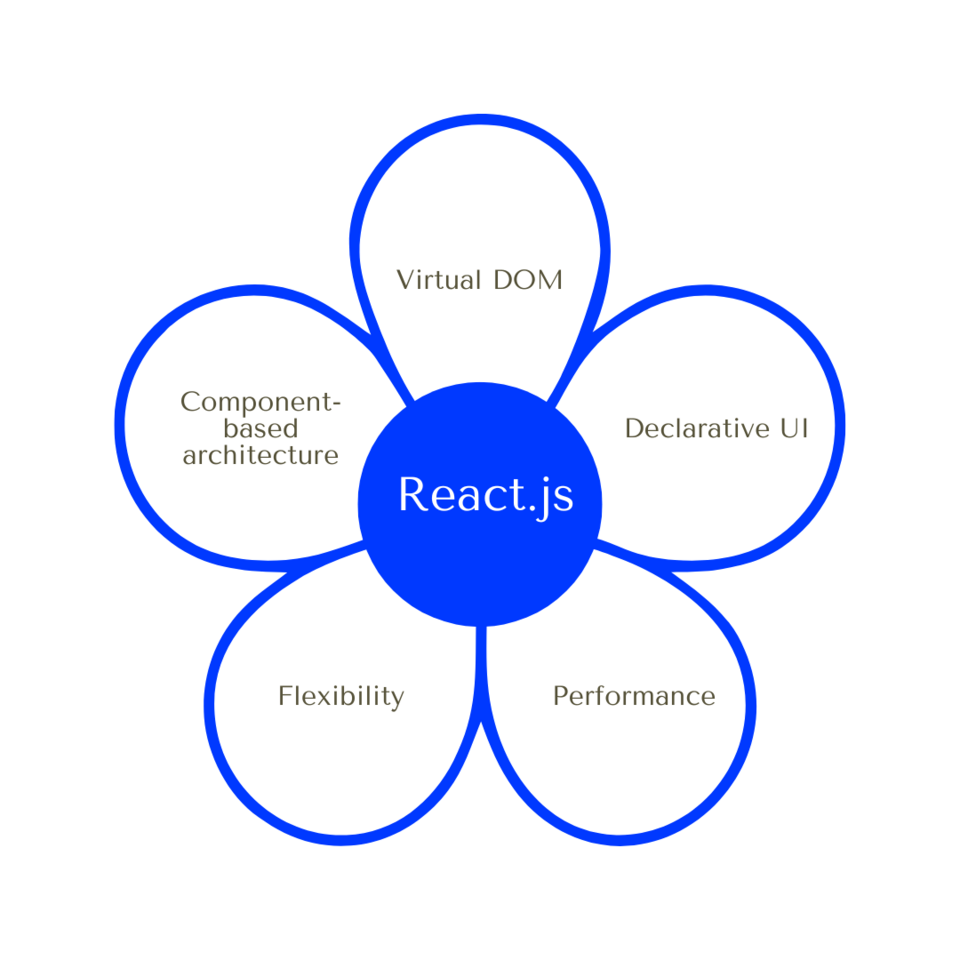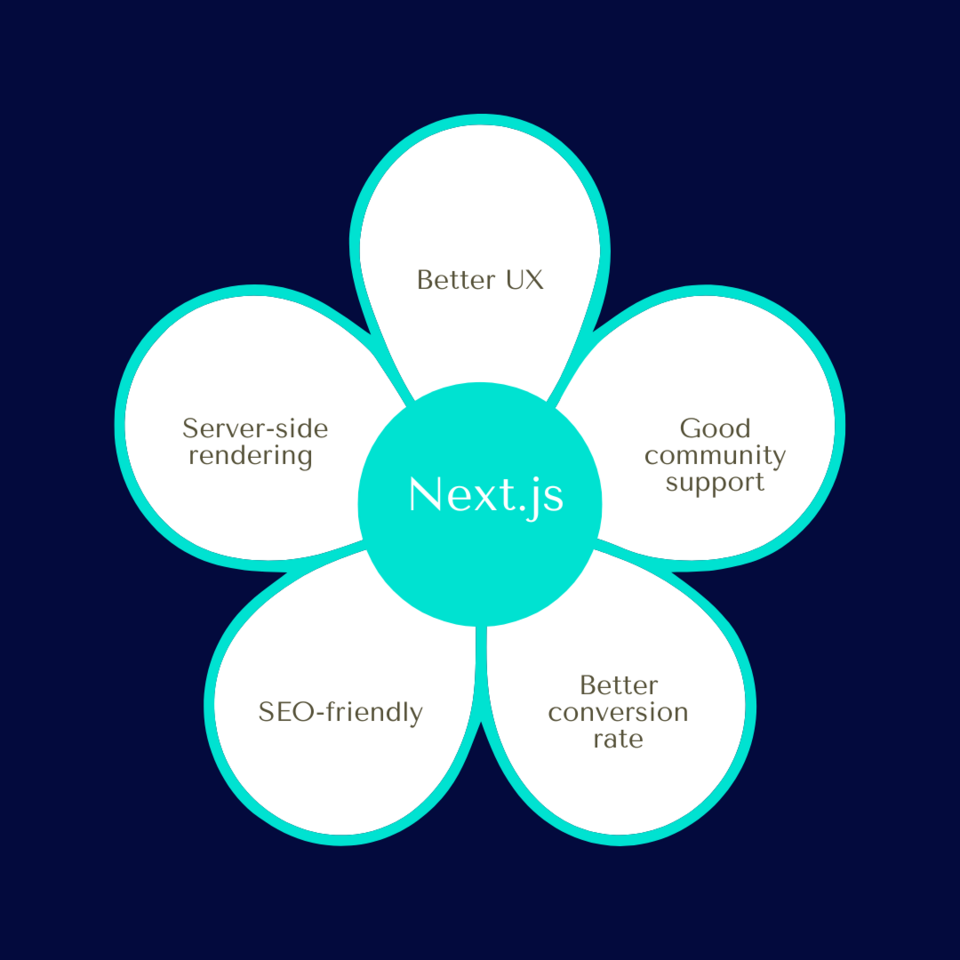
Next.js and React. How to Connect Them, and Why it May Be Beneficial?
Next.js and React are JavaScript-based technologies that are powerful tools in the frontend world. Each of them has robust features. By using both frameworks, our project can gain a lot. So in what cases is it worth combining Next.js and React? And how specifically should we do this? We’ll describe these issues and the features of both technologies in our article.
What is React.js?
React.js is a JavaScript library that serves to build interactive websites based on components. It was created by Facebook (currently Meta) and is constantly evolving, as evidenced by regularly released new versions.
The main goal of React is to allow developers to write user interfaces declaratively. This means that programmers define what they want to get without having to describe in detail how they want to achieve it. It’s a huge difference from traditional approaches, such as in jQuery, where developers had to instruct the JavaScript engine step by step - 'do this, turn here' and so on.
In React.js, the working principle is different. Developers describe the desired interface’s state, and all implementation details are hidden under the hood of the JavaScript engine. It allows us to focus on the final product rather than the technical details.

What is Next.js?
Next.js is a popular framework based on React.js, which introduces many improvements and features to meet the needs of today's web developers and projects. An excellent example of its strengths is its extensive ecosystem, which offers numerous useful elements, significantly speeding up the process of developing websites and applications.
Next.js introduces Server Side Rendering (SSR) - server-side code rendering. This ensures that the web page is mostly generated on the server and sent to the user's browser, resulting in better SEO and website performance. Using Next.js, we enjoy the benefits of React while dealing with its limitations.

How to combine Next.js with React?
Combining Next.js with React.js can be a great solution for many web projects that will provide both the flexibility of React and the additional features offered by Next.js. The two tools form a strong set that has the potential to meet the needs of different project types.
Next.js acts as an intermediate layer between React and the server, allowing for easier project control and maintenance. As a result, this first framework will be an excellent choice for simple and medium advanced websites, as it’ll allow for quickly deploying the project without using additional tools.
For more complex websites, on the other hand, while Next.js is still very useful, it may be necessary to add additional libraries and tools that can make such processes as site styling or form implementation easier and faster. This approach enables us to use ready-made, proven solutions instead of writing everything from scratch. It saves both time and resources.
In projects requiring advanced SEO features or higher performance, such as dynamic ecommerce web pages, the combination of Next.js and React.js can be precious. With the server-side rendering offered by Next.js, these websites will load faster and be better optimized for search engines.
Benefits of using Next.js and React.js in one project
Implementing both frontend frameworks in a single project can bring many benefits. Next.js and React.js offer various features and advantages that can make the process of developing and managing web applications much easier. Let's take a look at some of them.
Modularity and code reuse
Both Next.js and React.js promote the concept of components. This allows developers to create small, independent pieces of code that can be easily tested and reused in different areas in the same or a completely different application. It not only speeds up the software development process but also contributes to the cleanliness and maintainability of the code.
Open source
Next.js and React are supported by active communities constantly innovating, creating new libraries and tools, and providing educational resources. Access to rich sources of knowledge, help, and ready-to-use libraries makes the web development process easier and more efficient and the final product more secure.
Virtual DOM
Both technologies use the Virtual DOM (Document Object Model), which is a key element of their performance. The Virtual DOM is a lightweight copy of the actual DOM (document object model) that allows us to effectively manage changes to the website's structure without directly affecting the actual DOM. This translates into faster and more responsive interactions on the web page, as updates are first processed in the Virtual DOM and then efficiently transferred to the real DOM.
High performance
Thanks to Virtual DOM and SSR techniques, web pages created with React.js and Next.js are fast and efficient. This ensures a smooth and responsive user experience, regardless of the complexity of the application.
How does Next.js complement React?
Both frameworks have many features in common. However, as we mentioned in an earlier part of the article, Next.js has introduced various improvements and features to React. Let's take a look at some of them.
Routing
In React, routing is not built directly into the library, so developers must rely on additional libraries, such as React Router, to manage navigation between web pages. Unlike React, Next.js has built-in routing that is easy to use and integrate.
SSR and CSR
A final important addition to React is that Next.js supports server-side rendering (SSR), which is crucial for SEO and website performance. In contrast, React.js traditionally uses client-side rendering (CSR), which can lead to some limitations, especially regarding search engine optimization.
Meta-framework
Another key difference is that Next.js is a so-called meta-framework. It means that it’s not limited to React alone but also includes other solutions that, when combined, turn Next.js into a full-fledged toolkit for building a website from scratch to completion. As a result, Next.js gives developers more flexibility and possibilities than just React.
Next.js and React - summary
Both Next.js and React.js have a lot to offer for web developers. Combining these two technologies in a single project can bring many benefits, such as modularity, better SEO optimization of websites, community support, and high performance. Our developers are familiar with these tools, so they will be happy to take care of the frontend layer of your project.













